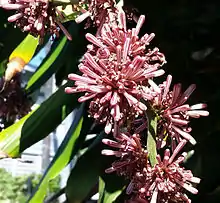Dracaena fragrans
Dracaena fragrans (cornstalk dracaena), is a flowering plant species that is native throughout tropical Africa, from Sudan south to Mozambique, west to Côte d'Ivoire and southwest to Angola, growing in upland regions at 600–2,250 m (1,970–7,380 ft) altitude.[1][2]
| Dracaena fragrans | |
|---|---|
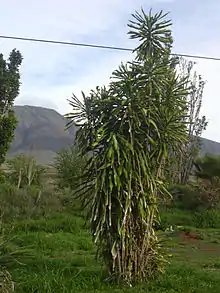 | |
| Cultivated plant in Hawaii | |
| Scientific classification | |
| Kingdom: | Plantae |
| Clade: | Tracheophytes |
| Clade: | Angiosperms |
| Clade: | Monocots |
| Order: | Asparagales |
| Family: | Asparagaceae |
| Subfamily: | Nolinoideae |
| Genus: | Dracaena |
| Species: | D. fragrans |
| Binomial name | |
| Dracaena fragrans | |
Description
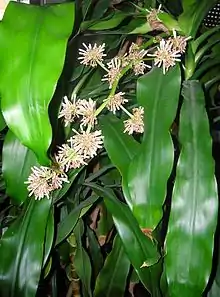
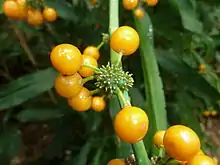
Dracaena fragrans is a slow growing shrub, usually multistemmed at the base, mature specimens reaching 15 m (49 ft) or more tall with a narrow crown of usually slender erect branches. Stems may reach up to 30 cm (12 in) diameter on old plants; in forest habitats they may become horizontal with erect side branches. Young plants have a single unbranched stem with a rosette of leaves until the growing tip flowers or is damaged, after which it branches, producing two or more new stems; thereafter, branching increases with subsequent flowering episodes.[1][3]
The leaves are glossy green, lanceolate, 20–150 cm (7.9–59.1 in) long and 2–12 cm (0.79–4.72 in) wide; small leaves are erect to spreading, and larger leaves usually drooping under their weight. The flowers are produced in panicles 15–160 cm (5.9–63.0 in) long, the individual flowers are 2.5 cm (0.98 in) diameter, with a six-lobed corolla, pink at first, opening white with a fine red or purple central line on each of the 7–12 mm (0.28–0.47 in) lobes; they are highly fragrant, and popular with pollinating insects. The fruit is an orange-red berry 1–2 cm (0.39–0.79 in) diameter, containing several seeds.[1][3]
Cultivation
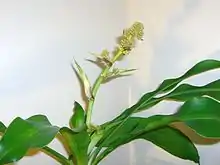
In Africa, D. fragrans is commonly grown as a hedge plant.[1] It is suited to frost-free climates and USDA Hardiness zones 10-11. Elsewhere, it is primarily popular as a houseplant and valued for its tolerance of a wide range of indoor conditions from full light to low light.[3] It is also very tolerant of neglect. The NASA Clean Air Study indicated that the plant aided removal of indoor pollutants such as formaldehyde, xylene, and toluene.[4] The plant is known as "masale" to the Chagga people of Tanzania, who regard it as holy.[5]
In cultivation in the Neotropics, a few generalist hummingbird species like the sapphire-spangled emerald (Amazilia lactea) visit the flowers.[6]
Cultivars
Several cultivars have variegated foliage. 'Massangeana', also commonly denominated "Mass Cane", has a bright yellow central stripe on the foliage. 'Compacta' is more compact and suitable for indoor cultivation. Other popular cultivars include 'Janet Craig', 'Lemon Lime', and 'Warneckei' ('Warneckii'), which are often sold under the synonym D. deremensis.[3]
The cultivars 'Lemon Lime',[7] ‘Massangeana’,[8] and 'Warneckei'[9] bear the Royal Horticultural Society's Award of Garden Merit.[10]
Propagation
Dracaena fragrans is propagated by cutting segments of old stems 10–20 cm (3.9–7.9 in) long, drying them, and then inserting them into moist sand until they root. New growth, typically being two or three shoots, comes from old foliar scars at the top of the stem.
Etymology and synonymy
The species name refers to the fragrant flowers, while the English name derives from a perceived resemblance of the stem to a corn (Zea mays) stalk. Synonyms include Aletris fragrans L. (basionym), Cordyline fragrans (L.) Planch., Pleomele fragrans (L.) Salisb., Sansevieria fragrans (L.) Jacq., Dracaena deremensis Engl., Dracaena smithii Hook.f., and Dracaena ugandensis Baker.[1][2] Other English names include striped dracaena (for variegated cultivars), corn plant (for the cultivar 'Massangeana';[3]), Chinese money tree, and fortune plant.[11]
The plant is known as "බෝතල් ගස් - bothal gas" (meaning "bottle tree") in Sinhala, in Sri Lanka.
References
- JSTOR Plant Science: Dracaena fragrans
- "Dracaena fragrans". Germplasm Resources Information Network (GRIN). Agricultural Research Service (ARS), United States Department of Agriculture (USDA). Retrieved 22 December 2017.
- Huxley, A., ed. (1992). New RHS Dictionary of Gardening 2: 96. Macmillan ISBN 0-333-47494-5.
- Wolverton, B. C. 1996. How to Grow Fresh Air. New York: Penguin Books.
- Stahl, Kathleen Mary (1964). History of the Chagga people of Kilimanjaro. Mouton. p. 60. OCLC 1382652.
- Baza Mendonça, Luciana & dos Anjos, Luiz. (2005). Beija-flores (Aves, Trochilidae) e seus recursos florais em uma área urbana do Sul do Brasil [Hummingbirds (Aves, Trochilidae) and their flowers in an urban area of southern Brazil]. [Portuguese with English abstract] Revista Brasileira de Zoologia 22 (1): 51–59. doi:10.1590/S0101-81752005000100007 PDF fulltext
- "RHS Plant Selector - Dracaena fragrans (Deremensis Group) 'Lemon Lime'". Retrieved 1 June 2020.
- "RHS Plantfinder - Dracaena fragrans 'Massangeana'". Retrieved 12 February 2018.
- "RHS Plant Selector - Dracaena fragrans (Deremensis Group) 'Warneckei'". Retrieved 1 June 2020.
- "AGM Plants - Ornamental" (PDF). Royal Horticultural Society. July 2017. p. 33. Retrieved 6 February 2018.
- MacDonald, Elvin "The World Book of House Plants" pp.238 Popular Books
External links
- Dressler, S.; Schmidt, M. & Zizka, G. (2014). "Dracaena fragrans". African plants – a Photo Guide. Frankfurt/Main: Forschungsinstitut Senckenberg.
| Wikimedia Commons has media related to Dracaena fragrans. |
| Wikispecies has information related to Dracaena fragrans. |
